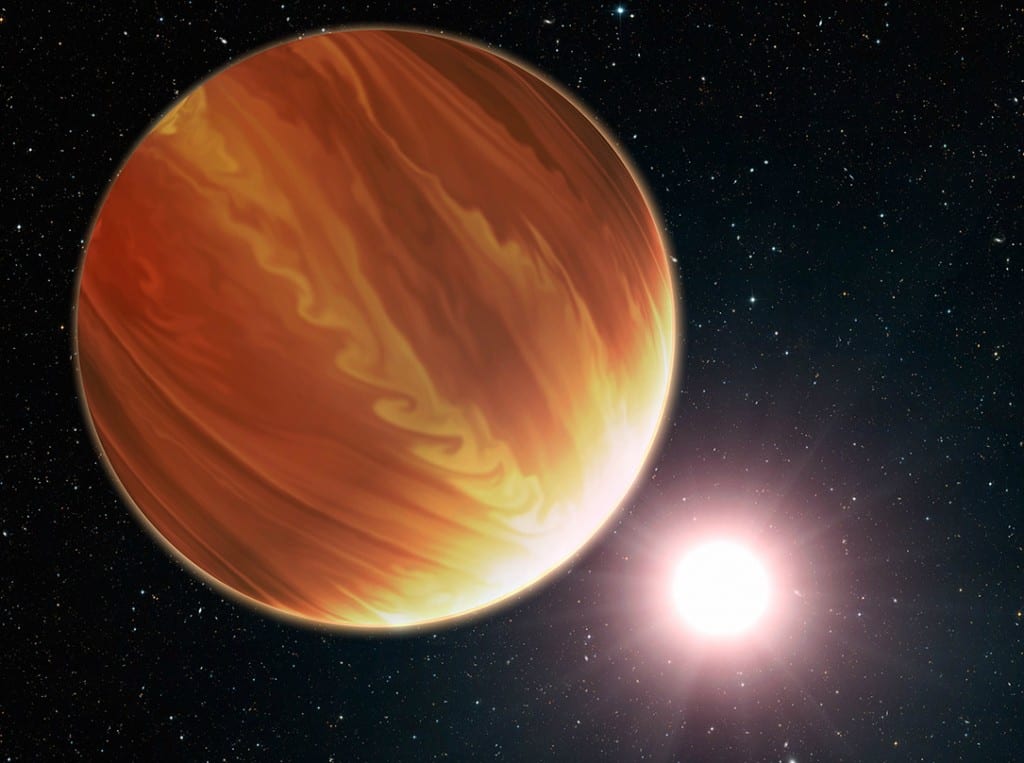
An artistic illustration of the gas giant planet HD 209458b in the constellation Pegasus. To the surprise of astronomers, they have found much less water vapor in the hot world’s atmosphere than standard planet-formation models predict: NASA
Astronomers using NASA’s Hubble Space Telescope have gone looking for water vapor in the atmospheres of three planets orbiting stars similar to the sun — and have come up nearly dry.
The three planets, known as HD 189733b, HD 209458b, and WASP-12b, are between 60 and 900 light-years away from Earth and were thought to be ideal candidates for detecting water vapor in their atmospheres because of their high temperatures where water turns into a measurable vapor.
These so-called “hot Jupiters” are so close to their star they have temperatures between 1,500 and 4,000 degrees Fahrenheit. However, the planets were found to have only one-tenth to one one-thousandth the amount of water predicted by standard planet-formation theories.
“Our water measurement in one of the planets, HD 209458b, is the highest-precision measurement of any chemical compound in a planet outside our solar system, and we can now say with much greater certainty than ever before that we’ve found water in an exoplanet,” said Nikku Madhusudhan of the Institute of Astronomy at the University of Cambridge, England. “However, the low water abundance we have found so far is quite astonishing.”
Madhusudhan, who led the research, said that this finding presents a major challenge to exoplanet theory.
“It basically opens a whole can of worms in planet formation,” he said. “We expected all these planets to have lots of water in them. We have to revisit planet formation and migration models of giant planets, especially “hot Jupiters,” and investigate how they’re formed.”
He emphasizes that these results may have major implications in the search for water in potentially habitable Earth-sized exoplanets. Instruments on future space telescopes may need to be designed with a higher sensitivity if target planets are drier than predicted.
“We should be prepared for much lower water abundances than predicted when looking at super-Earths (rocky planets that are several times the mass of Earth),” Madhusudhan said.
Using near-infrared spectra of the planets observed with Hubble, Madhusudhan and his collaborators estimated the amount of water vapor in each of the planetary atmospheres that explains the data.
The planets were selected because they orbit relatively bright stars that provide enough radiation for an infrared-light spectrum to be taken. Absorption features from the water vapor in the planet’s atmosphere are detected because they are superimposed on the small amount of starlight that glances through the planet’s atmosphere.
Detecting water is almost impossible for transiting planets from the ground because Earth’s atmosphere has a lot of water in it, which contaminates the observation.
“We really need the Hubble Space Telescope to make such observations,” said Nicolas Crouzet of the Dunlap Institute at the University of Toronto and co-author of the study.
The currently accepted theory on how giant planets in our solar system formed, known as core accretion, states a planet is formed around the young star in a protoplanetary disk made primarily of hydrogen, helium, and particles of ices and dust composed of other chemical elements. The dust particles stick to each other, eventually forming larger and larger grains. The gravitational forces of the disk draw in these grains and larger particles until a solid core forms. This then leads to runaway accretion of both solids and gas to eventually form a giant planet.
This theory predicts that the proportions of the different elements in the planet are enhanced relative to those in its star, especially oxygen, which is supposed to be the most enhanced. Once the giant planet forms, its atmospheric oxygen is expected to be largely encompassed within water molecules. The very low levels of water vapor found by this research raise a number of questions about the chemical ingredients that lead to planet formation.
“There are so many things we still don’t know about exoplanets, so this opens up a new chapter in understanding how planets and solar systems form,” said Drake Deming of the University of Maryland, who led one of the precursor studies. “The problem is that we are assuming the water to be as abundant as in our own solar system. What our study has shown is that water features could be a lot weaker than our expectations.”
The findings are published July 24 in The Astrophysical Journal Letters.
The Hubble Space Telescope is a project of international cooperation between NASA and the European Space Agency. NASA’s Goddard Space Flight Center in Greenbelt, Maryland, manages the telescope. The Space Telescope Science Institute (STScI) in Baltimore conducts Hubble science operations. STScI is operated for NASA by the Association of Universities for Research in Astronomy, Inc., in Washington.
For images and more information about Hubble, visit this Website and click here.
Before you continue, I’d like to ask if you could support our independent journalism as we head into one of the most critical news periods of our time in 2024.
The New American Journal is deeply dedicated to uncovering the escalating threats to our democracy and holding those in power accountable. With a turbulent presidential race and the possibility of an even more extreme Trump presidency on the horizon, the need for independent, credible journalism that emphasizes the importance of the upcoming election for our nation and planet has never been greater.
However, a small group of billionaire owners control a significant portion of the information that reaches the public. We are different. We don’t have a billionaire owner or shareholders. Our journalism is created to serve the public interest, not to generate profit. Unlike much of the U.S. media, which often falls into the trap of false equivalence in the name of neutrality, we strive to highlight the lies of powerful individuals and institutions, showing how misinformation and demagoguery can harm democracy.
Our journalists provide context, investigate, and bring to light the critical stories of our time, from election integrity threats to the worsening climate crisis and complex international conflicts. As a news organization with a strong voice, we offer a unique, outsider perspective that is often missing in American media.
Thanks to our unique reader-supported model, you can access the New American journal without encountering a paywall. This is possible because of readers like you. Your support keeps us independent, free from external influences, and accessible to everyone, regardless of their ability to pay for news.
Please help if you can.
American journalists need your help more than ever as forces amass against the free press and democracy itself. We must not let the crypto-fascists and the AI bots take over.
See the latest GoFundMe campaign here or click on this image.
Don't forget to listen to the new song and video.
Just because we are not featured on cable TV news talk shows, or TikTok videos, does not mean we are not getting out there in search engines and social media sites. We consistently get over a million hits a month.
Click to Advertise Here















